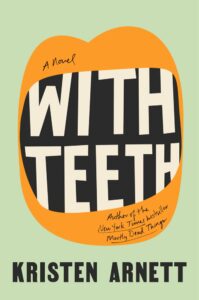
Kristen Arnett on Discovering the Shape of a Book
"It morphs as it builds. It refuses to hold still."
This first appeared in Lit Hub’s Craft of Writing newsletter—sign up here.
Quite often when I’m considering longer work, my mind inevitably drifts to its shape. It’s hard to describe exactly what I mean by that; it’s not the kind of thing where I could say, hey, this book right here is a parallelogram (a shape that still feels mysterious even as an adult, just a vividly remembered word from using play blocks in elementary school). It’s different. Much harder to pin down. For me, shape occasionally looks like story structure. Sometimes it feels like forming coherent plot. At other moments, character development. The thing about a novel’s shape is that it morphs as it builds. It refuses to hold still, wriggling around like a baby in the middle of a diaper change.
Every book I work on has some kind of initial, shadowy shape that lives rent-free in my head. That shape often shifts and changes as the book wears on. The shape of my last novel, Mostly Dead Things, developed as the story grew—the present and the past wove together, presenting a specific pattern. I realized once the draft was done that the entire book felt like sewing or embroidery; an apt comparison, given its theme of taxidermy. Linearity and non-linearity became the backbone (pun absolutely intended) of its final shape.
With Teeth, my second novel, was different. The book began with the shape of the family living inside of it. There was the shape of the domestic unit itself—a triangle of people—but also the shape of their shared stories. People in a household share common traits and lived experiences, but they also share stories that can wander away from each other. The way that a child remembers their first day of school isn’t exactly the way that their mother remembers it, right? I began to consider that everyone in a household is essentially an unreliable narrator. That’s when the real shape of the book began to manifest. What had initially felt like linked circles became a type of helix: combined threads that rotated around a fixed axis. Sometimes touching, but always leading away from each other.
I love to read novels and consider how the author decided on its shape. Was it intentional? Was it a subconscious decision? Some novels use time as the vehicle, others use an actual car. Some jump perspectives, launching from mind to mind. I like to imagine that last shape as a Super Mario Bros game. Will the next book I write resemble King Koopa’s lair? Only time will tell, but I’m willing to bet our Princess is in another castle.
*
Read more about crafting the shape of a story:
K Chess on writing a book within a book.
Joseph Scapellato on finding the right shape for a plot.
Elissa Washuta and Theresa Warburton on the relationship between form and content.
Martin Solares on drawing the shape of a story.
*
5 Novels with Interesting Shapes
RECOMMENDED BY KRISTEN ARNETT
Julie Buntin, Marlena
Jean Kyoung Frazier, Pizza Girl
Bryan Washington, Memorial
Carson McCullers, The Heart Is a Lonely Hunter
Mary Robison, Why Did I Ever?
__________________________________

With Teeth by Kristen Arnett is available via Riverhead Books.
Kristen Arnett
Kristen Arnett is the queer author of With Teeth: A Novel (Riverhead Books, 2021) which was a finalist for the Lambda Literary Award in fiction and the New York Times bestselling debut novel Mostly Dead Things (Tin House, 2019). Her work has appeared at The New York Times, TIME, The Cut, Oprah Magazine, The Guardian, Salon, The Washington Post, and elsewhere. Her next novel, CLOWN, will be published by Riverhead Books (Spring 2025). She has a Masters in Library and Information Science from Florida State University and lives in Orlando, Florida.



















